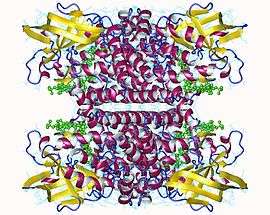Isovaleryl-CoA dehydrogenase
| isovaleryl-CoA dehydrogenase | |||||||||
|---|---|---|---|---|---|---|---|---|---|
|
Isovaleryl-CoA dehydrogenase tetramer, Human | |||||||||
| Identifiers | |||||||||
| EC number | 1.3.8.4 | ||||||||
| CAS number | 37274-61-6 | ||||||||
| Databases | |||||||||
| IntEnz | IntEnz view | ||||||||
| BRENDA | BRENDA entry | ||||||||
| ExPASy | NiceZyme view | ||||||||
| KEGG | KEGG entry | ||||||||
| MetaCyc | metabolic pathway | ||||||||
| PRIAM | profile | ||||||||
| PDB structures | RCSB PDB PDBe PDBsum | ||||||||
| Gene Ontology | AmiGO / EGO | ||||||||
| |||||||||
In enzymology, an isovaleryl-CoA dehydrogenase (EC 1.3.8.4) is an enzyme that catalyzes the chemical reaction
- 3-methylbutanoyl-CoA + acceptor 3-methylbut-2-enoyl-CoA + reduced acceptor
Thus, the two substrates of this enzyme are 3-methylbutanoyl-CoA and acceptor, whereas its two products are 3-methylbut-2-enoyl-CoA and reduced acceptor.
This enzyme belongs to the family of oxidoreductases, specifically those acting on the CH-CH group of donor with other acceptors. The systematic name of this enzyme class is 3-methylbutanoyl-CoA:acceptor oxidoreductase. Other names in common use include isovaleryl-coenzyme A dehydrogenase, isovaleroyl-coenzyme A dehydrogenase, and 3-methylbutanoyl-CoA:(acceptor) oxidoreductase. This enzyme participates in valine, leucine and isoleucine degradation. It employs one cofactor, FAD.
Structural studies
As of late 2007, only one structure has been solved for this class of enzymes, with the PDB accession code 1IVH.
References
- BACHHAWAT BK, ROBINSON WG, COON MJ (1956). "Enzymatic carboxylation of beta-hydroxyisovaleryl coenzyme A". J. Biol. Chem. 219 (2): 539–50. PMID 13319276.
- Ikeda Y, Tanaka K (1983). "Purification and characterization of isovaleryl coenzyme A dehydrogenase from rat liver mitochondria". J. Biol. Chem. 258 (2): 1077–85. PMID 6401713.
- Tanaka K, Budd MA, Efron ML, Isselbacher KJ (1966). "Isovaleric acidemia: a new genetic defect of leucine metabolism". Proc. Natl. Acad. Sci. U.S.A. 56 (1): 236–42. PMC 285701
 . PMID 5229850. doi:10.1073/pnas.56.1.236.
. PMID 5229850. doi:10.1073/pnas.56.1.236.
